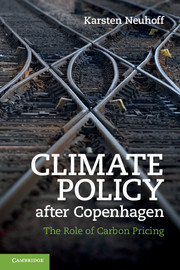Book contents
- Frontmatter
- Contents
- List of figures
- List of tables
- List of boxes
- Acknowledgements
- List of abbreviations
- 1 Introduction
- 2 The role of a climate policy mix
- 3 Implementing a carbon price: the example of cap and trade
- 4 Shifting investment to low-carbon choices
- 5 Co-operation among developed countries: a role for carbon markets?
- 6 A world of different carbon prices
- 7 International support for low-carbon growth in developing countries
- 8 Conclusion
- References
- Index
6 - A world of different carbon prices
Published online by Cambridge University Press: 05 June 2012
- Frontmatter
- Contents
- List of figures
- List of tables
- List of boxes
- Acknowledgements
- List of abbreviations
- 1 Introduction
- 2 The role of a climate policy mix
- 3 Implementing a carbon price: the example of cap and trade
- 4 Shifting investment to low-carbon choices
- 5 Co-operation among developed countries: a role for carbon markets?
- 6 A world of different carbon prices
- 7 International support for low-carbon growth in developing countries
- 8 Conclusion
- References
- Index
Summary
The previous chapter argued that countries and regions might pursue climate policies at different levels of ambition. This would probably include different carbon prices for a transition period, perhaps up to 2020. Now we will assess the implications of different carbon prices in countries connected by international trade. There are important opportunities and difficulties to consider. The opportunities lie in the first-mover advantages afforded to countries that support the development of low-carbon products and technologies. Just as Denmark's wind technologies have been established in world markets, new market leaders will emerge for other products.
But there is also some concern, that regions with high carbon price levels could risk inducing industry to alter investment, production and closure-decisions about plants, and thus move carbon-intensive production towards countries with lower or no carbon prices. This would have three implications that might have to be addressed by the design of the policy instrument and complementary measures.
Shifting of production in response to a more-stringent emissions cap and associated policy to a country without a stringent cap creates carbon leakage. The freed-up allowances in the first country will be used by other sectors that reduce their efforts in emissions reduction. Whenever some of the shifted production is not covered by a stringent national cap it will increase emissions in the new country and thus contribute to a global emissions increase.
Companies may limit passing through carbon prices to product prices either to protect current market shares, and hence delay relocation, or in response to output-based allocation of allowances. This dampens carbon-price signals for carbon-intensive commodities and services, reducing the economic incentive to substitute towards lower-carbon alternatives.
[…]
- Type
- Chapter
- Information
- Climate Policy after CopenhagenThe Role of Carbon Pricing, pp. 162 - 202Publisher: Cambridge University PressPrint publication year: 2011



